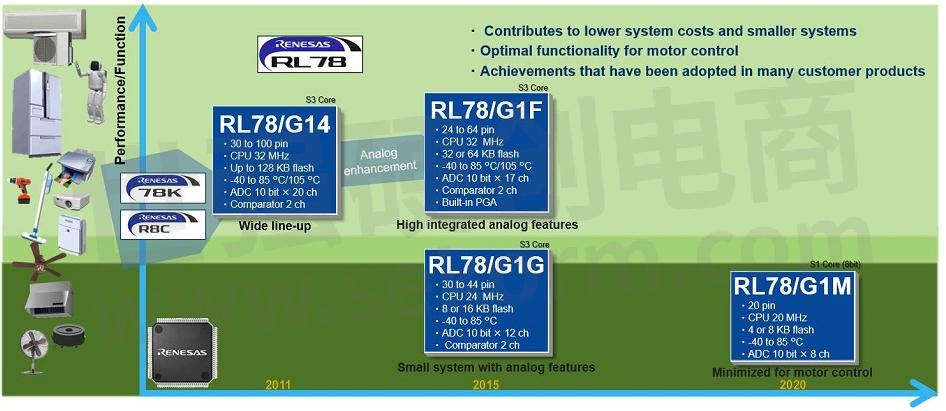Brushless Motor Control Realized with the Renesas RL78 8/16-bit MCU Family

There are many products with built-in motors around us, such as air conditioners, vacuum cleaners, and electric fans. As robots, drones, and electric vehicles, which are expected to make a big change in society in the future, become more widespread, more motors will be used.
Motors, which are familiar to us as described above, are classified into several types according to their structures. Among them, brushless motors are becoming widely used in home/industrial applications. The features of brushless motors are high efficiency, maintainability, and controllability. With the growing concern for environmental issues in recent years, the use of brushless motors that can be driven with high efficiency is desired. As the name "brushless" motor implies, there are no brushes in contact with the rotor, so there is no need to worry about brushes wearing out, which reduces the frequency and cost of maintenance. Brushed motors have the brush and commutator that constantly exert torque without a driving circuit due to their structural mechanism, whereas brushless motors have no such brushes and commutators. Instead, torque is generated by the MCU adjusting the direction and magnitude of the current in response to the position of the rotor, and high controllability can also be achieved such as keeping a constant speed even if the load changes.

There are two types of control methods that are often used for brushless motors: 120-degree conducting control and vector control. 120-degree conducting control uses six voltage patterns to drive the motor. This control method requires relatively fewer operations on the MCU but may cause vibration and noise because the angle of the torque acting on the rotor is not constant. On the other hand, Vector control is a control method in which the torque acting on the rotor is constantly in the vertical direction. This method requires a large number of operations on the MCU, but It is characterized by a small speed ripple. From this, vector control tends to be used in applications that require precise control.

RL78 is an 8/16-bit MCU featuring low power consumption. In RL78 series, RL78/G1F, RL78/G14, RL78/G1G and RL78/G1M are often used for motor control. The following are the features of each MCU.
RL78/G1F: Multifunctional MCU with enhanced functionality for motor control
RL78/G14: General purpose MCU with a wide line-up of pins, memory sizes and package types
RL78/G1G: Small system MCU with built-in analog peripheral functions
RL78/G1M: Compact MCU with the minimum functions required for motor control

120-degree conducting control, which requires a small amount of calculation, can be used with all four of these MCUs. On the other hand, vector control, which requires a large computational load, is realized by RL78/G1F and RL78/G14, which have relatively high computational power among the above MCUs. In addition to these control methods, we also develop solutions by utilizing the analog peripheral functions of the RL78/G1F, such as initial position detection, which estimates the angle of the rotor without sensors before rotation starts, and a high-speed rotation solution that performs 120-degree conducting control using a comparator.
We provide sample software that implements each of these control methods. With the sample software for 120-degree conducting control, speed control can be performed using Hall sensors or without sensors. In addition, for vector control, we prepare two types of sample software that perform sensorless speed control using one or three shunt resistors for current detection. We also offer the above-mentioned initial position detection and high-speed rotation solutions as sample software that can be used in specific applications. Furthermore, we plan to release a new sensorless vector control sample software for high-voltage applications. This sample software runs on the "T1003-A" high-voltage inverter board (input voltage range: AC 85 – 265 [Vrms], rated output current: AC 1 [Arms]) manufactured by Desk Top Laboratories Inc., and can be used for the development of high-voltage applications such as refrigerators, ceiling fans and conveyor belts.
We also provide a variety of development support tools to support the development of motor control solutions. Renesas Motor Workbench (RMW), a motor control evaluation tool, can measure motor characteristic parameters and display variable information recorded in the internal RAM of the MCU as waveform, etc. In addition, by using a porting support tool called Configuration File Generator (CFG), it is possible to automatically redesign the parameters for motor control when driving the motor using the development environment prepared by the customer.

- +1 Like
- Add to Favorites
Recommend
This document is provided by Sekorm Platform for VIP exclusive service. The copyright is owned by Sekorm. Without authorization, any medias, websites or individual are not allowed to reprint. When authorizing the reprint, the link of www.sekorm.com must be indicated.

























































































































































































































































































































































































































































































































































































































































































































































































































































































































